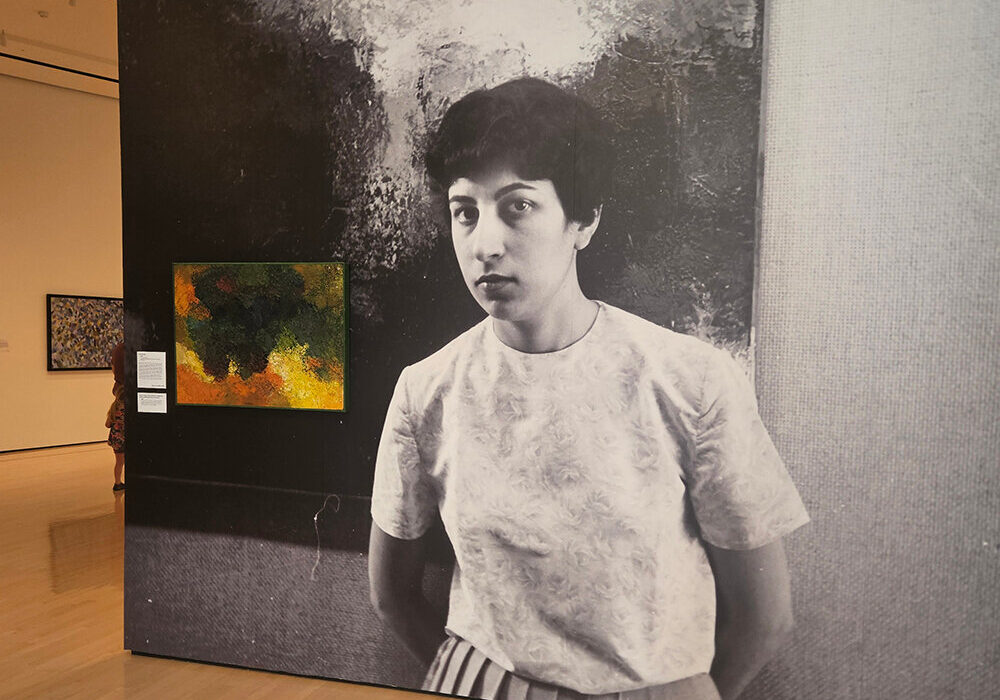By CHELSEA LAKE ROBERTS
In December, Indiana University canceled its planned exhibition of Palestinian American artist and master of fine arts alumna Samia Halaby’s work, citing concerns that its campus museum couldn’t “guarantee the integrity of the exhibit,” The New York Times reported.
Halaby has long been a vocal supporter of Palestine. The Times article reported that IU staff had raised concern over social media posts where the artist had “expressed support for Palestinian causes and outrage at the violence in the Middle East, comparing the Israeli bombardment to a genocide.”
In a comment for the same article, Steven Bridges, interim director of the Michigan State University Broad Art Museum, stated that MSU would remain on course to host Halaby’s work as planned.
On June 29, the first-ever American survey of Halaby’s work opened to the public right here in East Lansing. “Eye Witness,” running through Dec. 15, is a masterfully executed and meticulously curated effort, presenting a retrospective that delves deeply into the 87-year-old artist’s career as an abstract painter while creating an intimate dialogue with the audience through audio storytelling, short videos and engaging exhibition labels. The result is a warm, powerfully optimistic show that invites a deep connection with the artwork and a personal reflection on the artist.
Halaby was born in Jerusalem in 1936 and moved with her family to the United States when she was 11. She attended Michigan State University from 1959 to 1960, earning her master of arts degree. She told City Pulse, “During my year at MSU, painters from New York were invited as advisers for the graduate students. But I found the regular faculty, not the New York stars, far more helpful as teachers and far more interesting as personalities.”
Walking through the exhibition, viewers can explore work created during Halaby’s years as a student and an early-career artist, with some pieces on view for the first time since 1960. The definitions provided and questions posed throughout the exhibit help viewers understand how the artist approached her work and frame her abstract art practice as a “visual language” that viewers can have a conversation with.
In 1972, Halaby became the first full-time female associate professor at the Yale University School of Art. She’s lived and worked in New York City since 1976, but she struggled to find professional representation in a gallery for more than 30 years.
Frustrated with the harsh realities of the art world, Halaby turned to activism. In a video portrait, she states that activism is what “liberated” her artwork and, she says, “It liberated me.”
The exhibition also highlights Halaby’s pioneering work as a digital artist by showcasing her kinetic paintings, moving pieces of art she created via computer programming in the 1980s. In another video, she states, “The machine sitting in front of me is the artwork … the computer is the medium.” Visitors can explore videos of these paintings in a room designed to evoke the artist’s Tribeca studio, where she’s lived and worked for decades.
Some of the largest works on view are Halaby’s paintings from or about Palestine. The museum’s thoughtful curation of these paintings explores the multiple meanings of the word “occupation” — both how Halaby visited her homeland as an occupied territory and how this place occupies space in her mind. A subtle theme of the show is opening up new viewpoints, not because of the political situation in Palestine but because of the nature of abstract art.
In one of the video portraits, Halaby states, “Abstraction is an imitation of reality. It might teach you how to look if you open your eyes and look some more.” She continues to make her identity perfectly clear, “I am an Arab. And I am a lover of the Arab world. I am a Palestinian. I was born in Jerusalem, and it’s my city.”
The piece “Daughter in Her Mother’s Garden,” part of Halaby’s series “Women of Palestine,” was inspired by the artist’s visit to Balata refugee camp in the West Bank, where she met a woman who meticulously tended a garden. Moved by the woman’s perseverance, Halaby abstracted a scene of scattered pastel dots that evoke snow, dust and things breaking apart, contrasted with large shapes holding together or flowing.
Halaby’s 2003 piece “Little Palestine” is now part of the Broad’s permanent collection. The collaged canvas was stitched together by the artist to create, according to the Broad, “a dynamic sense of movement” evoking the artist’s identity and her experiences between Palestine and the United States.
While these two pieces are among the most powerful, the show’s name, “Eye Witness,” was inspired by Halaby’s painting “Occupied Jerusalem 1, June 9, 1995.” Rachel Winter, assistant curator of the Broad, writes in the exhibition’s program, “Being an eyewitness expands beyond an immediate field of vision into a complex physical, emotional, environmental and intellectual experience … to be a witness is not simply to see visually, but to be present, engaged and mindful of a fleeting moment so its events are not forgotten.”
Halaby’s endurance over her 60-year career could be credited to her ability to embrace new forms and adapt to the times while wholeheartedly advocating for herself, whatever the cost or the controversy. In one video, Halaby wanders around a large canvas taped to the floor and occasionally adds a line or a large circle to it. Her niece can be heard off-camera, joking about how her aunt is “destroying” the painting she has just made. Halaby responds, “The biggest danger is self-deception — falling in love with your own baby, being blind to what everyone else sees.”

